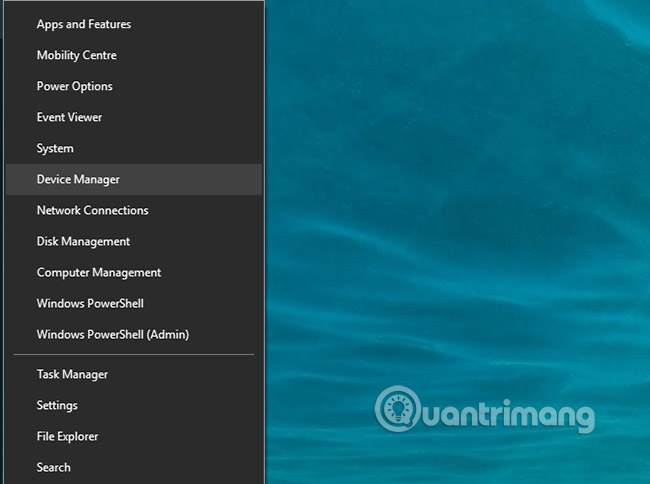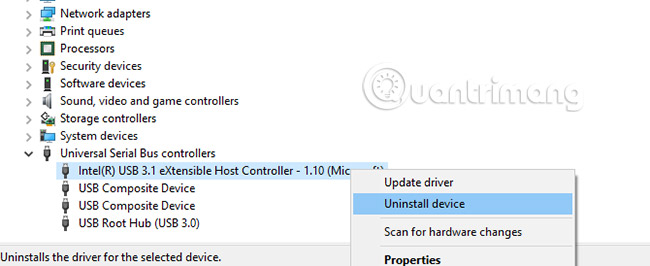How to diagnose and troubleshoot broken USB ports
Have you connected a USB device or other device to your computer via USB but haven't seen anything working? It is likely that USB ports have problems.
What can you do to fix this? Here's how to diagnose and fix suspicious issues related to USB ports.
How to diagnose and troubleshoot broken USB ports
- USB port not working? Check for 'health' for it
- Fix broken USB hardware
- Is it possible to restart the computer to repair broken USB ports?
- Check Device Manager on Windows 10
- Try disabling the USB Selective Suspend feature
USB port not working? Check for 'health' for it

Before continuing, note that you need to make sure that the port is faulty, not the device you are connecting to.
To find out exactly what the problem is, connect the device to another USB port. If it works, the problem is due to the USB port. If the second USB port still does not receive the device, the device has failed. If you cannot reformat the USB drive, it will need to be replaced.
- 4 ways to fix USB errors without formatting: 'Windows was unable to complete the format'
If there's a problem with your USB port, you'll notice that thanks to one of the following signs:
- Device not detected
- Your operating system displays error messages related to the device (removing and replacing devices can solve this problem).
Either way, you should consider the status of the USB port. It was broken for what reason? The safest way to find out is to turn off your computer or laptop.
Next, look at the USB port. Is it clean and free of dust? If you are using a desktop or USB port on the back of the PC, there is a chance that dirt may have clung to these ports and caused an error.
Dust will reduce airflow, making your system too hot. It is especially harmful to laptops, where hardware overheating can reduce performance in seconds. Clean the drive with a vacuum cleaner, for example.
Finally, grab a USB cable (or flash drive, or whatever) and gently lay it. If the drive is moving and has a loose feel - usually it will move up and down - then you have a problem with the USB port.
Fix broken USB hardware
The article will look at some software fixes for a moment, but first, what happens if the USB port is loose?
The ports are soldered to a table in your computer. This may be a motherboard, but usually a secondary printed circuit board (PCB). With regular use, ports can be moved, sometimes welds are completely flipped.
Usually, this is the shape of the connected USB devices. Although Wi-Fi, Bluetooth and even the new USB flash memory card are not capable of causing any pressure on the physical connection of the port, the old memory is another story. The USB cable is the same. Their size and corresponding weight act as a kind of lever, contributing to making the USB ports loose.
Replacing USB ports is not easy. On the desktop, you can easily find replacement circuit boards. However, if you are using a laptop, you may need to use electric welding. Here is an example of what you might need to do to solder the USB connector to your laptop:
Of course, you can go to a specialist to fix this problem, but will incur related costs. If you want to do it yourself, make sure you know how to weld. If you are not sure, check the software first.
Is it possible to restart the computer to repair broken USB ports?
Did you try to turn off the computer and turn it on again? This way is simple but extremely effective!
With an unrecognizable USB device, correctly plugged into a USB port that suspects a problem, restart your computer. When the operating system has restarted, it will detect the USB device. If not, you should see the device in Windows Device Manager.
Check Device Manager on Windows 10
Start by right-clicking on the Start menu and selecting Device Manager.

Device Manager lists devices that are attached to your computer, grouping them into categories. It is arranged alphabetically, so you should find Universal Serial Bus controllers at the end of the list.
Expand the list and find the USB Host Controller . The device you are trying to find may have a longer title but it will have three words.

If the USB Host Controller is not found, this may explain why your USB device is not working. To fix this, click the Scan for hardware changes button in the toolbar. This step will start checking all connected hardware and in most cases will detect the USB port or anything connected to it.
If this still doesn't work, you should take the time to reinstall the USB Host Controllers. Right-click in turn on the USB Host Controller entry and select Uninstall on each item. Wait until they are uninstalled, then restart the computer.
When Windows restarts, the USB Host Controllers will be reset automatically. This "refresh" operation can help troubleshoot problems with the USB port.
Note that if you are using a USB mouse or a device with a USB port, it will be turned off if the USB Host Controllers are uninstalled.
Try disabling the USB Selective Suspend feature
If the power management setting is overwritten with your USB controller, this will affect device detection. This is especially relevant if you use a laptop. If you want to keep your energy usage low, you may have set low power options on your Windows 10 desktop.
USB Selective Suspend is a power-saving setting for cutting off the power of a USB device, thereby reducing battery usage.
This feature usually works well, but sometimes causes problems with your USB port.

Fix this error by opening the Windows Control Panel. This is best done by clicking Start and entering control panel. Click the corresponding result, then select Hardware and Sound> Power Options . Here, click Change plan settings , then Change advanced power settings .
Here, find the USB Settings and expand this setting to find suspicious USB suspend settings. Change the menu to Disabled, then click Apply and OK to confirm. Restart your PC to make sure this change is applied.
As you can see, you have several options to repair a corrupted USB port. In most cases, it will not 'die' really, and you will be able to fix it. Remember, when your USB port is not working, you need to:
- Carry out actual inspection
- If necessary, physically repair the port
- Restart Windows
- Check Device Manager, uninstall the USB Host Controller
- Turn off the USB Selective Suspend energy saving option
USB port is not the only potential weakness on your computer. Finding your hardware will reduce the chance of other potential errors. You can also save a lot of money if you know how to check your PC hardware.
Good luck!
See more:
- How does the computer not accept USB?
- How to enable / disable USB drive / port on Windows 7/8/10?
- Fix some common errors when using USB
You should read it
- 16 connection ports are commonly found on computers and their functions
- Why do some modern computers still have Serial ports?
- What is DVI port? Classification of popular DVI ports today
- How to check the ports in use in Windows 10
- How to connect printer 2.0 USB port to USB 3.0 port on Windows 10
- How to fix missing USB printer port on Windows 10
 4 great USB utilities that you may not know yet
4 great USB utilities that you may not know yet Is it necessary to disconnect secure USB devices?
Is it necessary to disconnect secure USB devices? Important notes when choosing to buy USB
Important notes when choosing to buy USB Learn about Flash Memory Toolkit
Learn about Flash Memory Toolkit Things to know about USB fingerprint reader
Things to know about USB fingerprint reader